Infrared Thermography for Non-Destructive Testing of Cooling Hole Integrity and Flow Evaluation in Specimens Made with Innovative Technologies †
Abstract
1. Introduction
2. Material and Methods
2.1. Experimental Setup and Campaign with CO2
- Ambient temperature (D)
- Absolute pressure (E)
- Gauge pressure (F)
2.2. Experimental Setup and Campaign with Compressed Air
3. Procedure for Data Analysis and Preliminary Results
3.1. Data Analysis with CO2
- (a)
- Signal Background Evaluation: The signal background was assessed as the mean of 10 frames acquired at the beginning of the test, prior to the application of the CO2 flux.
- (b)
- Steady-State Condition: After reaching steady-state conditions, a thermal sequence of duration 2 s (250 frames) was acquired.
- (c)
- Mean Evaluation: The mean values of the thermal data were computed along the third dimension (time), resulting in a single thermal map.
- (d)
- Background Subtraction: The assessed signal background was subtracted from the mean thermal map calculated in (c).
- (e)
- Cumulative Frame Subtraction: The mean background subtraction (a) point) was applied to each frame of the acquired sequence, and then the resulting frames were summed. The cumulative frame subtraction was an algorithm present in the IRTA 2 software (by DES) that allowed us to enhance the signal to noise ratio.
- (f)
3.2. Data Analysis with Compressed Air
4. Results
4.1. Results with CO2
4.2. Results with Compressed Air
5. Conclusions and Outlooks
Author Contributions
Funding
Institutional Review Board Statement
Informed Consent Statement
Data Availability Statement
Conflicts of Interest
References
- Li, Z.Y.; Wei, X.T.; Guo, Y.B.; Sealy, M.P. State-of-art, challenges, and outlook on manufacturing of cooling holes for turbine blades. Mach. Sci. Technol. 2015, 19, 361–399. [Google Scholar] [CrossRef]
- Swaminathan, V.P.; Allen, J.M. Surface degradation and cracking in combustion turbine blade cooling passages. Mater. Manuf. Process 1995, 10, 867–885. [Google Scholar] [CrossRef]
- Chowdhury, T.S.; Mohsin, F.T.; Tonni, M.M.; Mita MN, H.; Ehsan, M.M. A critical review on gas turbine cooling performance and failure analysis of turbine blades. Int. J. Thermofluids 2023, 18, 100329. [Google Scholar] [CrossRef]
- Ozaner, O.C.; Karabulut, Ş.; Izciler, M. Study of the surface integrity and mechanical properties of turbine blade fir trees manufactured in Inconel 939 using laser powder bed fusion. J. Manuf. Process. 2022, 79, 47–59. [Google Scholar] [CrossRef]
- Tinga, T.; Van Kampen, J.F.; De Jager, B.; Kok, J.B. Gas turbine combustor liner life assessment using a combined fluid/structural approach. J. Eng. Gas Turbines Power. 2007, 129, 69–79. [Google Scholar] [CrossRef]
- Doroshtnasir, M.; Krankenhagen, R.; Maierhofer, C.; Block, N.; Binder, P. Volumenstrombestimmung an gasdurchflossenen Düsen mit Thermografie. In Proceedings of the DACH-Jahrestagung 2012-ZfP in Forschung, Entwicklung und Anwendung, Graz, Austria, 17–19 September 2012; No. DGZfP-BB 136. p. Poster-34. [Google Scholar]
- Goldammer, M.; Heinrich, W.D. Method and Device for Determining Component Parameters by Means of Thermography. Patent DE102006043339A1, 11 November 2010. [Google Scholar]
- Jonsson, I.; Chernoray, V.; Dhanasegaran, R. Infrared thermography investigation of heat transfer on outlet guide vanes in a turbine rear structure. Int. J. Turbomach. Propuls. Power 2020, 5, 23. [Google Scholar] [CrossRef]
- Simon, B.; Filius, A.; Tropea, C.; Grundmann, S. IR thermography for dynamic detection of laminar-turbulent transition. Exp. Fluids 2016, 57, 93. [Google Scholar] [CrossRef]
- Gardner, A.D.; Eder, C.; Wolf, C.C.; Raffel, M. Analysis of differential infrared thermography for boundary layer transition detection. Exp. Fluids 2017, 58, 122. [Google Scholar] [CrossRef]
- Carlomagno, G.M.; Cardone, G. Infrared thermography for convective heat transfer measurements. Exp. Fluids 2010, 49, 1187–1218. [Google Scholar] [CrossRef]
- Carlomagno, G.M.; Cardone, G.; Meola, C.; Astarita, T. Infrared thermography as a tool for thermal surface flow visualization. J. Vis. 1998, 1, 37–50. [Google Scholar] [CrossRef]
- Astarita, T.; Cardone, G.; Carlomagno, G.M. Infrared thermography: An optical method in heat transfer and fluid flow visualisation. Opt. Lasers Eng. 2006, 44, 261–281. [Google Scholar] [CrossRef]
- Rajic, N. Principal Component Thermography; Defence Science and Technology Organisation: Melbourne, Australia, 2002. [Google Scholar]
- Omar, M.A.; Parvataneni, R.; Zhou, Y. A combined approach of self-referencing and Principle Component Thermography for transient, steady, and selective heating scenarios. Infrared Phys. Technol. 2010, 53, 358–362. [Google Scholar] [CrossRef]
- D’Accardi, E.; Palumbo, D.; Galietti, U. Experimental procedure to assess depth and size of defects with pulsed thermography. J. Nondestruct. Eval. 2022, 41, 41. [Google Scholar] [CrossRef]
- Feuillet, V.; Ibos, L.; Fois, M.; Dumoulin, J.; Candau, Y. Defect detection and characterization in composite materials using square pulse thermography coupled with singular value decomposition analysis and thermal quadrupole modeling. NDT E Int. 2012, 51, 58–67. [Google Scholar] [CrossRef]
- Dell’Avvocato, G.; Palumbo, D. Thermographic procedure for the assessment of Resistance Projection Welds (RPW): Investigating parameters and mechanical performances. J. Adv. Join. Process. 2024, 9, 100177. [Google Scholar] [CrossRef]
- D’Accardi, E.; De Finis, R.; Dell’Avvocato, G.; Masciopinto, G.; Palumbo, D.; Galietti, U. Conduction thermography for non-destructive assessment of fatigue cracks in metallic materials. Infrared Phys. Technol. 2024, 140, 105394. [Google Scholar] [CrossRef]
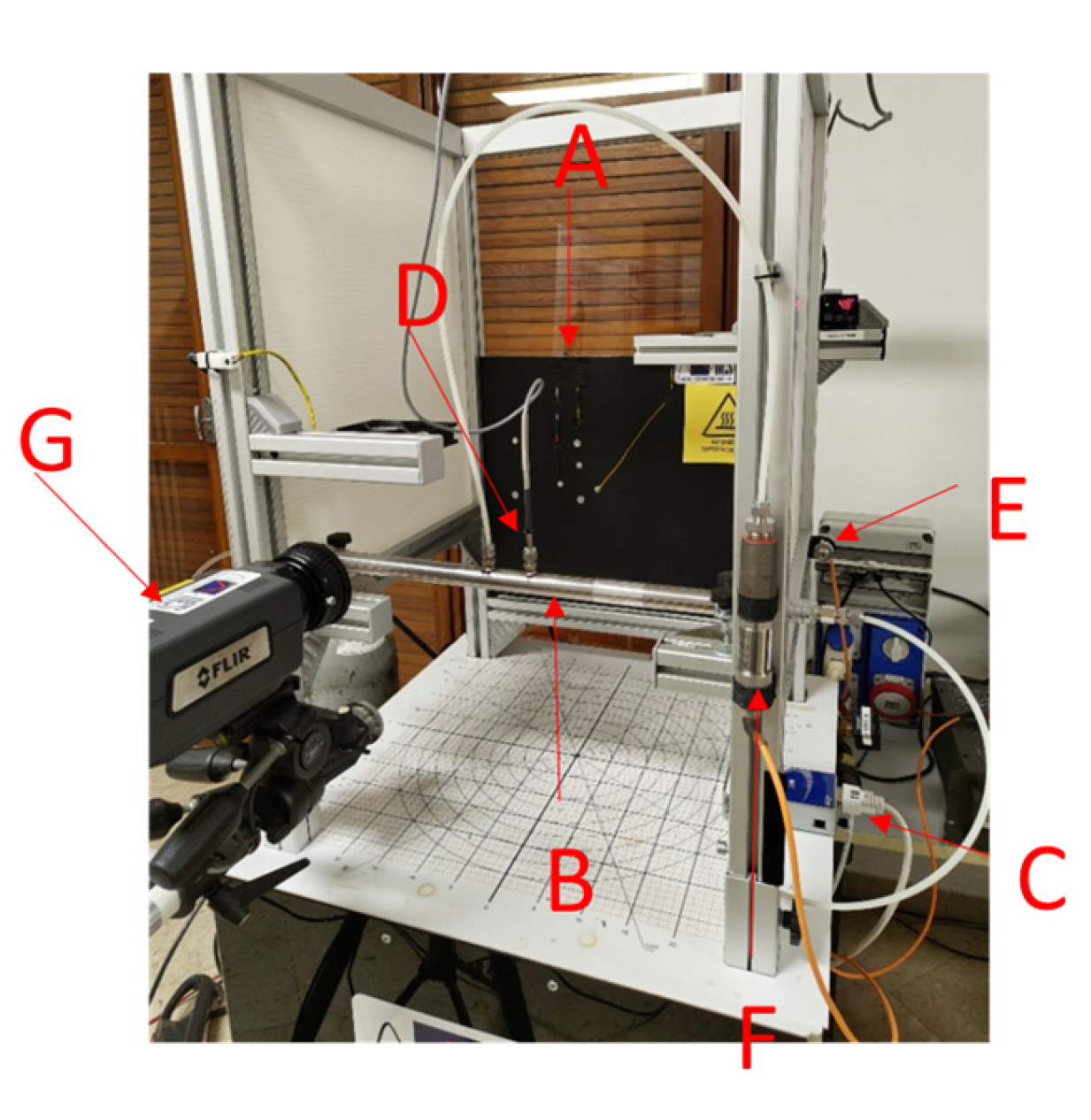


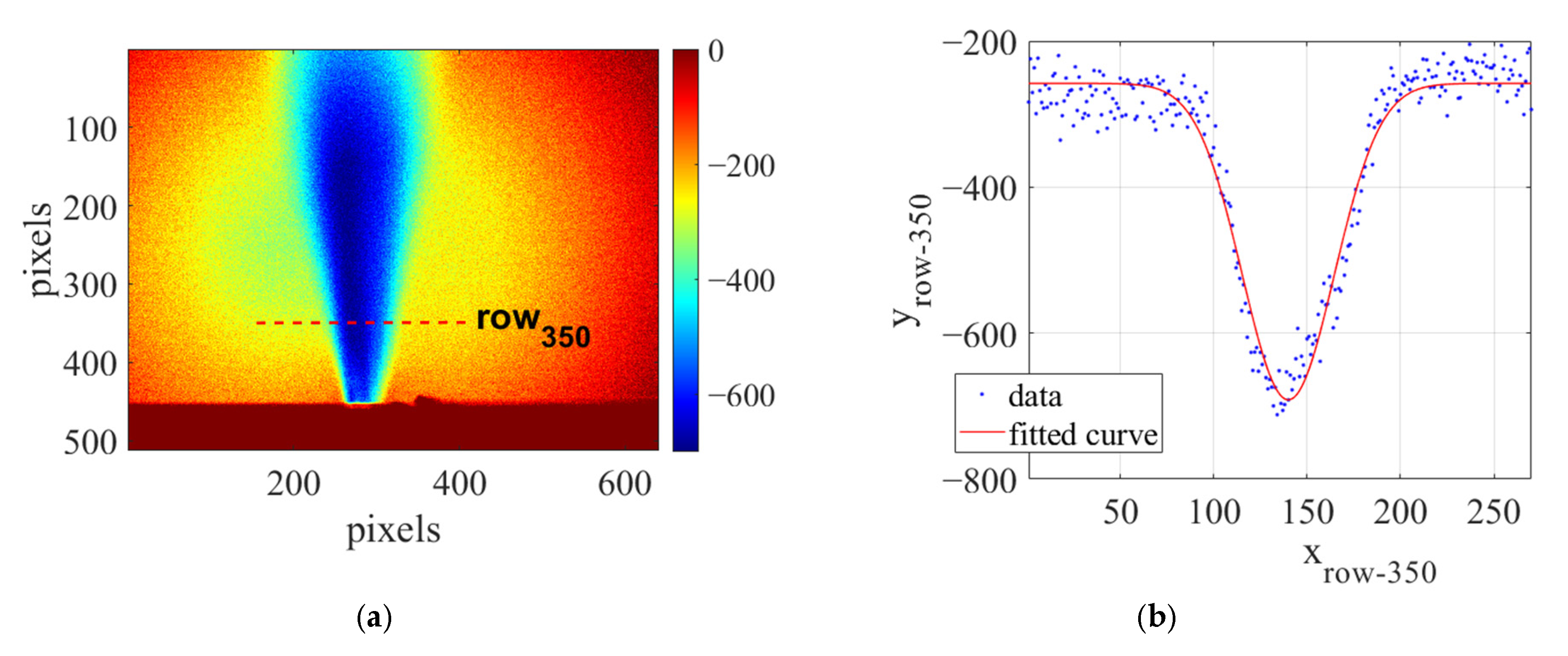
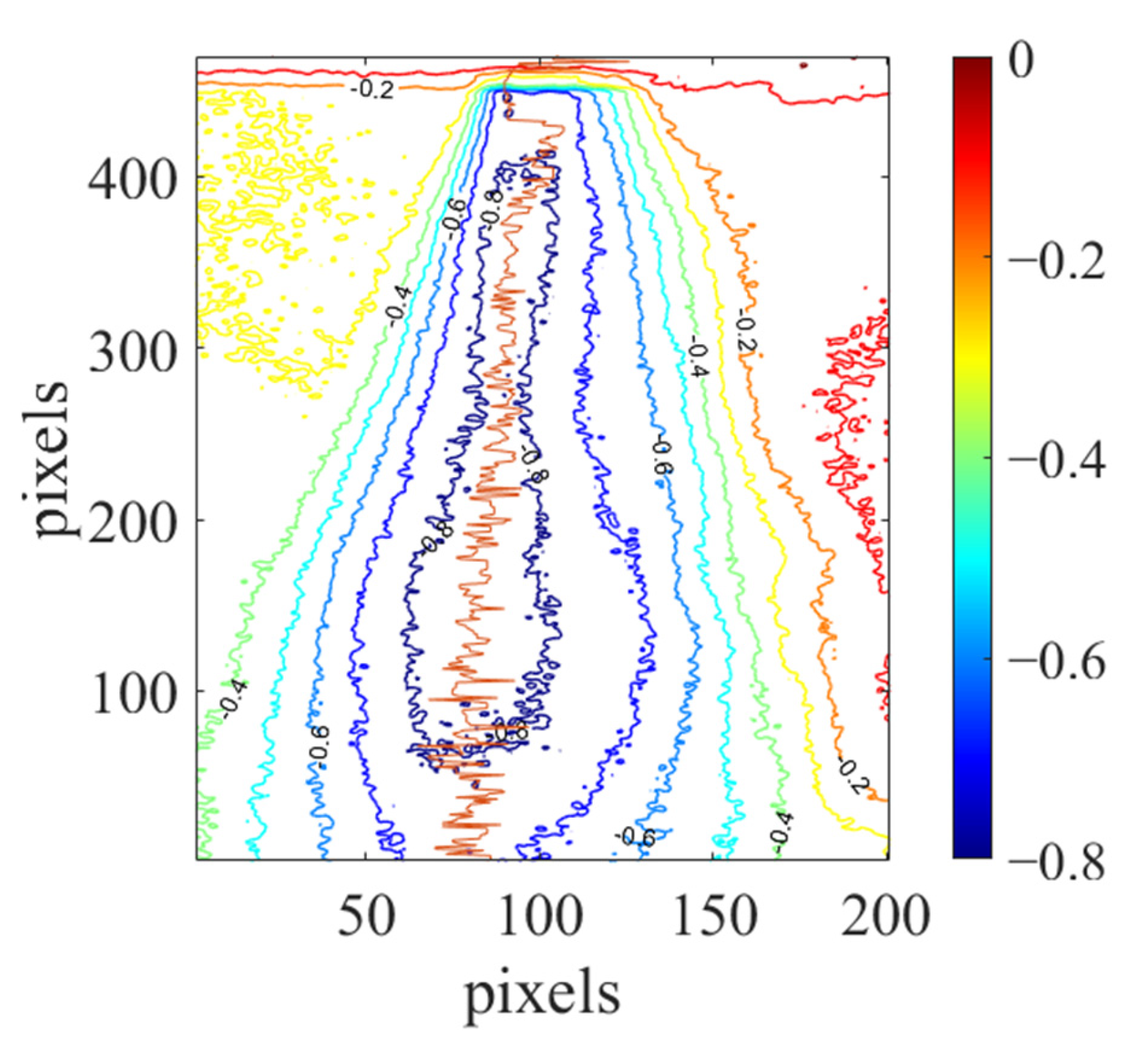
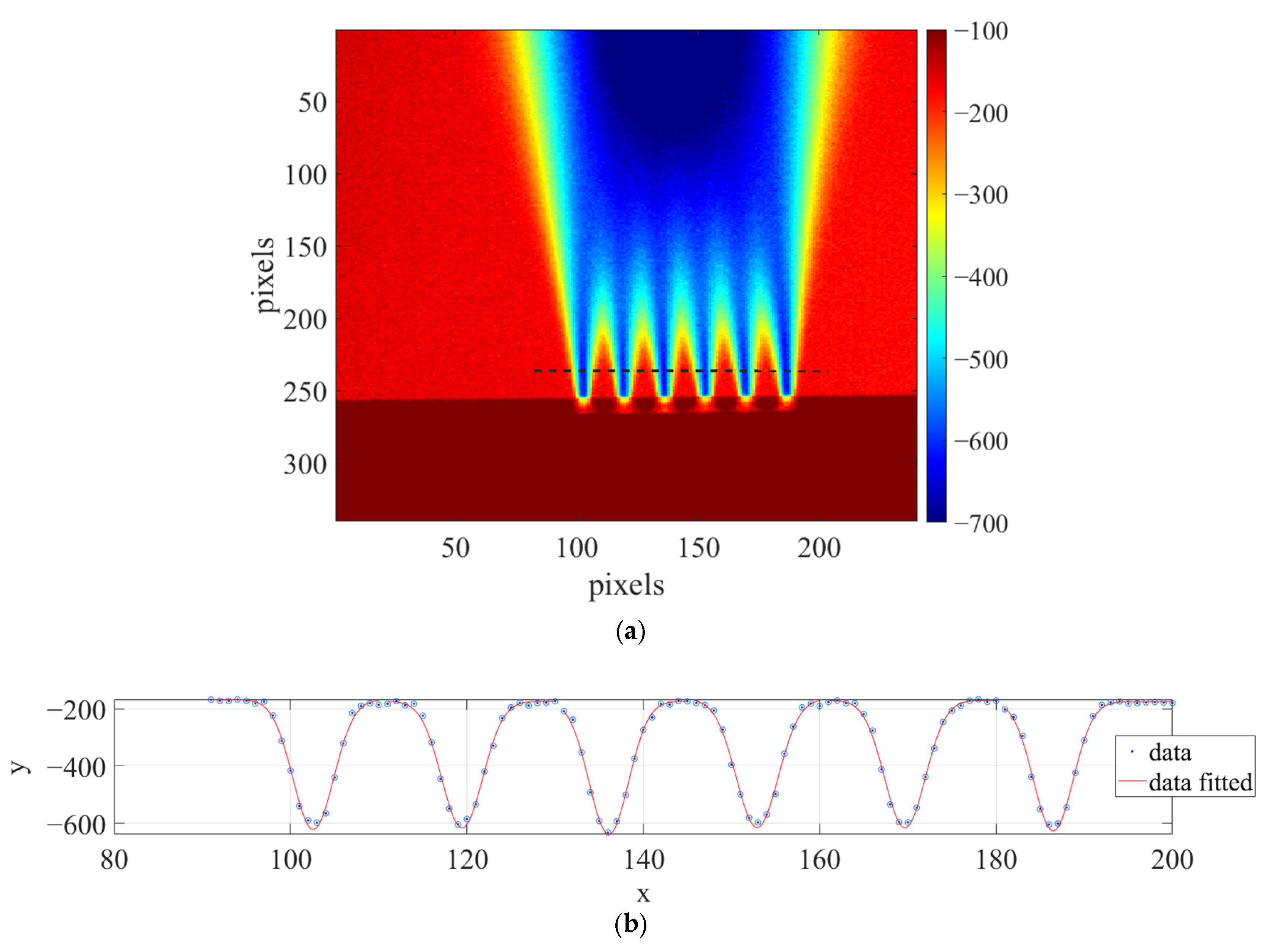

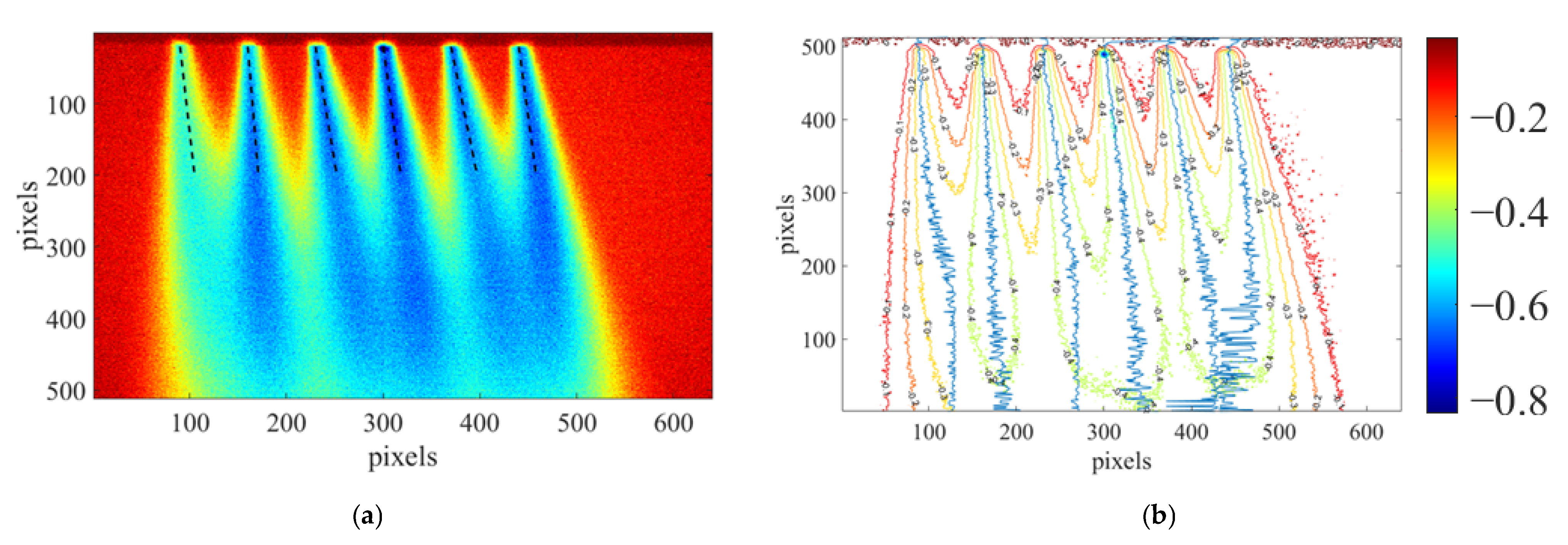

| Hole Diameter (mm) | Edge Distance—Step (mm) |
|---|---|
| 0.5 | 1 |
| 0.7 | 1.5 |
| 1 | 2 |
| 1.4 | 2.5 |
| Integration Time (µs) | Temperature Range (°C) | Geometrical Resolution (mm/pixel) | Frame Rate (Hz) | Pressure Level (bar) | Flow Reading (L/min) | Number of Tests |
|---|---|---|---|---|---|---|
| 2.37 | −10–55 | 0.003–0.13 | 125 | fixed | different | 16 × 5 |
| Hole Diameter (mm) | Edge Distance (mm) |
|---|---|
| 0.8 | 2.2 |
| 0.9 | 2.2 |
| 1 | 2.2 |
| 1.1 | 2.2 |
| Integration Time (ms) | Temperature Range (°C) | Geometrical Resolution (mm/pixel) | Frame Rate (Hz) | Number of Tests |
|---|---|---|---|---|
| 0.97 | 10–90 | 0.15 | 300 | 5 |
| Thermal Features | amplitude | standard deviation | area |
| Gaussian Fitting (D 0.7 mm, Step 1.5 mm) | Hole1 | Hole2 | Hole3 | Hole4 | Hole5 | Hole6 |
|---|---|---|---|---|---|---|
| amplitude | 452 | 446 | 449 | 465 | 443 | 454 |
| standard deviation | 3.19 | 3.28 | 3.38 | 3.17 | 3.30 | 3.27 |
| area | 2544 | 2648 | 2489 | 2600 | 2604 | 2641 |
| area (trapz) | 2538 | 2644 | 2476 | 2598 | 2600 | 2632 |
| flow reading tot (@ steady state) [L/min] | 13.2 | 13.2 | 13.2 | 13.2 | 13.2 | 13.2 |
| Gaussian Fitting | Ø 1.4 mm | Ø 1 mm | Ø 0.7 mm | Ø 0.5 mm |
|---|---|---|---|---|
| amplitude | 628 | 434 | 418 | 326 |
| standard deviation | 6.71 | 4.45 | 3.29 | 2.44 |
| area | 5942 | 3404 | 2523 | 1912 |
| area (trapz) | 5923 | 3381 | 2565 | 1908 |
| flow reading tot (steady state—L/min) | 14.8 | 14.1 | 13.4 | 11.3 |
| Contour Plot Analysis (Ø 0.9 mm, Step 2.2 mm—AM Material) | Hole1 | Hole2 | Hole3 | Hole4 | Hole5 | Hole6 |
|---|---|---|---|---|---|---|
| slope coefficient | −9.81 | −6.69 | −9.88 | −8.11 | −16.98 | −8.34 |
| flow intensity (absolute minimum value) | −0.39 | −0.48 | −0.49 | −0.51 | −0.47 | −0.50 |
Disclaimer/Publisher’s Note: The statements, opinions and data contained in all publications are solely those of the individual author(s) and contributor(s) and not of MDPI and/or the editor(s). MDPI and/or the editor(s) disclaim responsibility for any injury to people or property resulting from any ideas, methods, instructions or products referred to in the content. |
© 2025 by the authors. Licensee MDPI, Basel, Switzerland. This article is an open access article distributed under the terms and conditions of the Creative Commons Attribution (CC BY) license (https://creativecommons.org/licenses/by/4.0/).
Share and Cite
D’Accardi, E.; Ammannato, L.; Giannasi, A.; Pieri, M.; Masciopinto, G.; Ancona, F.; Santonicola, G.; Palumbo, D.; Galietti, U. Infrared Thermography for Non-Destructive Testing of Cooling Hole Integrity and Flow Evaluation in Specimens Made with Innovative Technologies. Eng. Proc. 2025, 85, 15. https://doi.org/10.3390/engproc2025085015
D’Accardi E, Ammannato L, Giannasi A, Pieri M, Masciopinto G, Ancona F, Santonicola G, Palumbo D, Galietti U. Infrared Thermography for Non-Destructive Testing of Cooling Hole Integrity and Flow Evaluation in Specimens Made with Innovative Technologies. Engineering Proceedings. 2025; 85(1):15. https://doi.org/10.3390/engproc2025085015
Chicago/Turabian StyleD’Accardi, Ester, Luca Ammannato, Alessandra Giannasi, Marco Pieri, Giuseppe Masciopinto, Francesco Ancona, Giovanni Santonicola, Davide Palumbo, and Umberto Galietti. 2025. "Infrared Thermography for Non-Destructive Testing of Cooling Hole Integrity and Flow Evaluation in Specimens Made with Innovative Technologies" Engineering Proceedings 85, no. 1: 15. https://doi.org/10.3390/engproc2025085015
APA StyleD’Accardi, E., Ammannato, L., Giannasi, A., Pieri, M., Masciopinto, G., Ancona, F., Santonicola, G., Palumbo, D., & Galietti, U. (2025). Infrared Thermography for Non-Destructive Testing of Cooling Hole Integrity and Flow Evaluation in Specimens Made with Innovative Technologies. Engineering Proceedings, 85(1), 15. https://doi.org/10.3390/engproc2025085015









